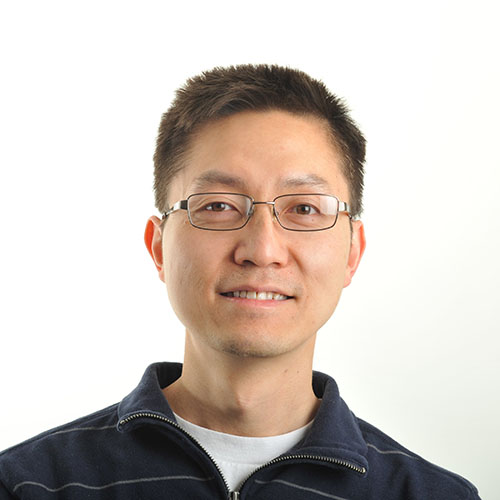

 C. Shan Xu
C. Shan Xu Isotropic high-resolution imaging of large volumes provides unprecedented opportunities to understand cellular architecture and advance connectomics, which are essential for life science. Conventional Focused Ion Beam Scanning Electron Microscopy (FIB-SEM) offers unique benefits such as high resolution (< 10 nm) and robust image alignment. However, its prevailing deficiencies in imaging speed and duration cap the maximum possible image volume. Here, I will take you on the journey of transforming FIB-SEM from a conventional lab tool that is unreliable for more than a few days to a robust volume Electron Microscopy (vEM) imaging platform with 100% effective reliability: capable of years of continuous imaging without defects in the final image stack. As a result, we have expanded the imageable volume by more than four orders of magnitude from 103 µm3 to 3 x 107 µm3 while maintaining isotropic 8 x 8 x 8 nm3 voxels. Moreover, by trading off imaging speed, the system can achieve even higher resolutions at 4 x 4 x 4 nm3 voxels. Primarily limited by time, the maximum volume can be readily extended.
The expanded volumes enabled by this enhanced FIB-SEM technology open up a vast new regime in scientific learning, where nano-scale resolution coupled with meso and even macro scale volumes is critical. The largest connectome (https://neuprint.janelia.org) to date has been generated at 8 x 8 x 8 nm3 voxels. Likewise, higher resolution further improves the interpretation of otherwise ambiguous details. The ability of enhanced FIB-SEM to image whole cells and tissues at 4-nm isotropic voxels over large volumes makes it an ideal tool to map in toto the 3D ultrastructural relationship of organelles and protein complexes in living systems. Combined with super-resolution fluorescence imaging, correlative light-electron microscopy (CLEM) applications unleash the full potential of intracellular organelle and protein identification. Furthermore, we establish a reference library of whole cells and tissues with open access (https://openorganelle.janelia.org) to inspire wider research community to explore comprehensive cellular architecture. Finally, we envision this is the beginning of a new transformative field and a holistic way of looking into the neuronal circuitry and cellular world, which will ultimately lead us to the understanding of how the brain works and how cells function.
 C. Shan Xu’s primary research interest is transformative instrumentation development enabling discoveries from basic science to engineering. His interdisciplinary inventions (20 plus patents) and numerous publications cover areas of physical chemistry, semiconductor engineering, and biology. Shan received his B.S. degree from University of Science and Technology of China, and his Ph.D. degree from University of California at Berkeley, both in Physical Chemistry. After graduation, he joined Lam Research Corporation in 1997, growing from an entry level engineer to a technical director in the R&D department, developing and disseminating advanced technology/equipment to serve worldwide customers. Curiosity of how the brain works led Shan to join the Howard Hughes Medical Institute in 2009, where he has pioneered and developed the enhanced FIB-SEM technology for large-volume 3D imaging at Janelia Research Campus. Over the past decade, Shan has transformed FIB-SEM from a conventional lab tool lacking long term reliability to a robust imaging platform with 100% effective reliability, expanding the imageable volume by more than four orders of magnitude, enabling the largest and most detailed connectome to date, and revealing transformational discoveries in cell biology. As the head of FIB-SEM Technology division, Shan’s current focus is to develop new generation platforms offering even faster image acquisition with larger volumes, and disseminate this transformative technology beyond life science to benefit much wider research communities world-wide.
C. Shan Xu’s primary research interest is transformative instrumentation development enabling discoveries from basic science to engineering. His interdisciplinary inventions (20 plus patents) and numerous publications cover areas of physical chemistry, semiconductor engineering, and biology. Shan received his B.S. degree from University of Science and Technology of China, and his Ph.D. degree from University of California at Berkeley, both in Physical Chemistry. After graduation, he joined Lam Research Corporation in 1997, growing from an entry level engineer to a technical director in the R&D department, developing and disseminating advanced technology/equipment to serve worldwide customers. Curiosity of how the brain works led Shan to join the Howard Hughes Medical Institute in 2009, where he has pioneered and developed the enhanced FIB-SEM technology for large-volume 3D imaging at Janelia Research Campus. Over the past decade, Shan has transformed FIB-SEM from a conventional lab tool lacking long term reliability to a robust imaging platform with 100% effective reliability, expanding the imageable volume by more than four orders of magnitude, enabling the largest and most detailed connectome to date, and revealing transformational discoveries in cell biology. As the head of FIB-SEM Technology division, Shan’s current focus is to develop new generation platforms offering even faster image acquisition with larger volumes, and disseminate this transformative technology beyond life science to benefit much wider research communities world-wide.